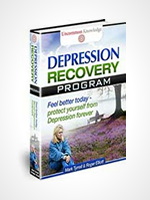All or Nothing', or 'Black and White' Thinking and Depression
MOST life events are not 'completely disastrous' or 'absolutely wonderful' but contain elements of both good and bad. Depression makes people think in absolutes.
All or Nothing, or 'Black and White' thinking is the thought pattern that allows us to generate a "flight or fight" response to danger. It is still needed in the world today, but not many times a day in relation to non-life-threatening stress, as so often happens with depression.
Because All or Nothing thinking is emotionally arousing, it causes over-dreaming and maintains depression, as described in the page on understanding depression.
All or Nothing thinking and depression
All or Nothing thinking is found in depressed people all over the World. This is because it is part of the most primitive of human responses: The Fight or Flight Response.
When faced with a life-threatening situation, we must make a snap decision and act on it. There is no time for 'maybe this', or 'maybe that'.
Either decision will create an emotional reaction to allow us to fight or flee to the maximum of our ability.
Earlier in the Depression Learning Path, we talked about the importance of tolerating uncertainty when looking to overcome depression. All or Nothing thinking is the opposite of this. In a survival situation, there is no room for uncertainty, we simply have to decide to either run away or fight. Uncertainty causes hesitation, which would increase our chances of being killed.
But these responses evolved for times that were much more physically threatening. These days they are rarely required, at least not to that extent.
Seeing shades of gray
Since All or Nothing thinking is another thinking style strongly linked with depression, learning not to always think in 'all or nothing' terms but to see shades of gray is immensely helpful in tackling depression. It greatly reduces, or stops the emotionally-arousing thoughts that are necessary to maintain the depressed state.
The more we polarize our thinking the more likely we are to become depressed because extreme either/or thinking stimulates the emotions much more. Statements like "I'm a terrible person!" or "She's perfect; she's a saint!" or "I'm just a failure!" oversimplify life and cause massive emotional swings. Few marriages, holidays or jobs were 'complete disasters' but had different elements within them.
From this, you would expect that people prone to depression also get much 'higher' when positively excited. And indeed this is true, research shows that people who suffer from depression often need less stimulation to get really 'up'.
For a healthy emotional life, it's not more extreme happiness we need, but balanced emotions.
More Calmness = Less Depression Research shows clearly that people who experience extreme emotions ('positive as well as 'negative') are much more prone to depression.(1)
So, if you are 'addicted' to getting high levels of emotional stimulation from experiences, conversations, relationships and so on, it could be time you started doing with less.
For less depression, it's not more happiness we need, it's more calmness.
Spotting warning words
As an ongoing way of perceiving reality, All or Nothing thinking is emotionally and physically damaging. If you spot yourself using this style, challenge yourself to think differently. There are particular words that people often use when thinking in this way. You can learn to spot them.
|
Always
|
Never
|
Perfect
|
|
Impossible
|
Awful
|
Terrible
|
|
Ruined
|
Disastrous
|
Furious
|
Of course, thinking and talking in an 'All or Nothing' way is much more emotionally exciting, and so may be difficult to give up. However, we all talk like this at times, particularly when excited or angry.
To look at how we can begin to incorporate the "gray", take for example a child failing a math exam.
They could say to themselves: 'I'm just plain stupid!' or they could say: ' I'm bad at math but I'm pretty good at English' (or sport, art, making people laugh or whatever it happens to be). The first statement is Black or White while the second focuses on lots of different elements and is not indicative of depressive thinking.
(Note how this ties in with Explanatory Styles earlier in the Depression Learning Path.)
We can all make inner statements about ourselves but that doesn't make them true. Consider the following questions:
|
Becoming less rigid in our thinking allows us to avoid using All or Nothing statements to depress ourselves without examining their validity. Using this 'cognitive' technique will literally allow you to spot what you are doing and therefore challenge its accuracy.
Remember: A major reason people depress is because of the way they perceive reality. Once this begins to broaden, depression has little to cling on to and will start to lift. Depression often centers around one recurring belief, such as "I'm just not the sort of person other people like."
Deliberately challenging this and coming up with alternative evidence starts to break down the depression. This can often be easier with the help of a friend or properly-trained therapist.
An important note: trauma (PTSD) and depression
People who suffer from post traumatic stress disorder (PTSD) may find that they become depressed. The symptoms of PTSD are intrusive, terrifying 'flashbacks' to the original tramua, which keep the brain in a high state of emotional arousal.
In this state, it is extremely difficult to think in a balanced way, because as we have already seen, when emotionally aroused, the brain's default mode of thinking is 'all or nothing'. In addition, the thought that life will always be as difficult as it is when experiencing traumatic flashbacks is a depressing one in itself.
Happily, we can now stop flashbacks in a single session using the 'rewind' technique (a version of the neuro-linguistic programming (NLP) 'fast phobia cure.) (2)
Critical incident debriefing, the most widely available approach to treating trauma often makes the condition worse.(3,4)
Often, removal of PTSD in depressed people is enough in itself to lift their depression.
Next article: Understanding Depression Summary
- Martin, P. (1997) The Sickening Mind: brain, behaviour, immunity and disease. HarperCollins.
- Guy, K. and Guy, N. (2003) The fast cure for phobia and trauma: evidence that it works. Human Givens, 9, 4, 31-35
- Wessley, S., Rose, S. and Bisson, J.A. (1999). A systematic review of brief psychological interventions ("debriefing") for the treatment of immediate trauma-related symptoms and the prevention of post-traumatic stress disorder (PTSD).
- Tehrani, N. (1998) Debriefing: a safe way to defuse emotion? The Therapist, 5, 3, 24-29.







